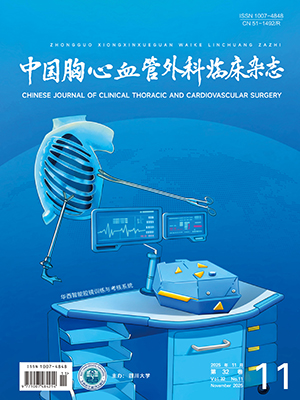| 1. |
Gudbjartsson T, Ahlsson A, Geirsson A, et al. Acute type A aortic dissection: a review. Scand Cardiovasc J, 2020, 54(1): 1-13.
|
| 2. |
Salmasi MY, Al-Saadi N, Hartley P, et al. The risk of misdiagnosis in acute thoracic aortic dissection: a review of current guidelines. Heart, 2020, 106(12): 885-891.
|
| 3. |
Ahmed Y, Houben IB, Figueroa CA, et al. Endovascular ascending aortic repair in type A dissection: a systematic review. J Card Surg, 2021, 36(1): 268-279.
|
| 4. |
田力, 樊晓寒, 朱俊, 等. A型急性主动脉夹层患者血浆D二聚体浓度和住院死亡的关系. 中国循环杂志, 2013, 28(6): 450-454.Tian L, Fan XH, Zhu J, et al. Relationship between level of plasma D-dimer and in-hospital mortality in patients with type A acute aortic dissection. Chin Circ J, 2013, 28(6): 450-454.
|
| 5. |
Sen I, Erben YM, Franco-Mesa C, et al. Epidemiology of aortic dissection. Semin Vasc Surg, 2021, 34(1): 10-17.
|
| 6. |
Yan TD, Tian DH, LeMaire SA, et al. Standardizing clinical end points in aortic arch surgery: a consensus statement from the International Aortic Arch Surgery Study Group. Circulation, 2014, 129(15): 1610-1616.
|
| 7. |
Zhu Y, Lingala B, Baiocchi M, et al. Type A aortic dissection-experience over 5 decades: JACC historical breakthroughs in perspective. J Am Coll Cardiol, 2020, 76(14): 1703-1713.
|
| 8. |
Feng W, Wang Q, Li C, et al. Significant prediction of in-hospital major adverse events by D-dimer level in patients with acute type A aortic dissection. Front Cardiovasc Med, 2022, 9: 821928.
|
| 9. |
Sievers HH, Rylski B, Czerny M, et al. Aortic dissection reconsidered: type, entry site, malperfusion classification adding clarity and enabling outcome prediction. Interact Cardiovasc Thorac Surg, 2020, 30(3): 451-457.
|
| 10. |
Dagenais F. Commentary: how aggressive should we be in replacing the aortic root during type A dissection? J Thorac Cardiovasc Surg, 2022, 163(3): 911-912.
|
| 11. |
Pupovac SS, Hemli JM, Seetharam K, et al. Acute type A aortic dissection repair after hours: does it influence outcomes? Ann Thorac Surg, 2020, 110(5): 1622-1628.
|
| 12. |
Zhang Y, Chen T, Chen Q, et al. Development and evaluation of an early death risk prediction model after acute type A aortic dissection. Ann Transl Med, 2021, 9(18): 1442.
|
| 13. |
Liu T, Zheng J, Zhang YC, et al. Association between D-dimer and early adverse events in patients with acute type A aortic dissection undergoing arch replacement and the frozen elephant trunk implantation: a retrospective cohort study. Front Physiol, 2020, 10: 1627.
|
| 14. |
Nezu T, Kitano T, Kubo S, et al. Impact of D-dimer levels for short-term or long-term outcomes in cryptogenic stroke patients. J Neurol, 2018, 265(3): 628-636.
|
| 15. |
Faller N, Limacher A, Méan M, et al. Predictors and causes of long-term mortality in elderly patients with acute venous thromboembolism: a prospective cohort study. Am J Med, 2017, 130(2): 198-206.
|
| 16. |
Freund Y, Cohen-Aubart F, Bloom B. Acute pulmonary embolism: a review. JAMA, 2022, 328(13): 1336-1345.
|
| 17. |
Ha SH, Kim YJ, Heo SH, et al. Prediction of deep vein thrombosis by ultrasonography and D-dimer in Asian patients with ischemic stroke. BMC Neurol, 2020, 20(1): 257.
|
| 18. |
Fan YN, Ke X, Yi ZL, et al. Plasma D-dimer as a predictor of intraluminal thrombus burden and progression of abdominal aortic aneurysm. Life Sci, 202, 240: 117069.
|
| 19. |
Weber T, Rammer M, Auer J, et al. Plasma concentrations of D-dimer predict mortality in acute type A aortic dissection. Heart, 2006, 92(6): 836-837.
|
| 20. |
Ohlmann P, Faure A, Morel O, et al. Diagnostic and prognostic value of circulating D-Dimers in patients with acute aortic dissection. Crit Care Med, 2006, 34(5): 1358-1364.
|
| 21. |
Xie N, Zhang W, Li H, et al. Admission values of plasma biomarkers predict the short-term outcomes in acute aortic dissection. Heart Surg Forum, 2021, 24(1): E048-E054.
|
| 22. |
Huang B, Yang Y, Lu H, et al. Impact of D-dimer levels on admission on inhospital and long-term outcome in patients with type A acute aortic dissection. Am J Cardiol, 2015, 115(11): 1595-1600.
|
| 23. |
Itagaki R, Kimura N, Mieno M, et al. Characteristics and treatment outcomes of acute type A aortic dissection with elevated D-dimer concentration. J Am Heart Assoc, 2018, 7(14): e009144.
|
| 24. |
Tang Z, Liu H, Shao Y. Efficacy of CRP in combination with D-dimer in predicting adverse postoperative outcomes of patients with acute Stanford type A aortic dissection. J Cardiothorac Surg, 2022, 17(1): 71.
|
| 25. |
Han L, Dai L, Li HY, et al. Elevated D-dimer increases the risk of dialysis after surgery in patients with Stanford A aortic dissection through the impact of the coagulation system. J Thorac Dis, 2018, 10(12): 6783-6793.
|
| 26. |
Yin ZQ, Han H, Yan X, et al. Research progress on the pathogenesis of aortic dissection. Curr Probl Cardiol, 2023, 48(8): 101249.
|
| 27. |
Li M, Xu S, Yan Y, et al. Association of biomarkers related to preoperative inflammatory and coagulation with postoperative in-hospital deaths in patients with type A acute aortic dissection. Sci Rep, 2021, 11(1): 18775.
|
| 28. |
Chen Y, Lin Y, Zhang H, et al. Relationship of platelet counts and inflammatory markers to 30-day mortality risk in patients with acute type A aortic dissection. Biomed Res Int, 2020, 2020: 1057496.
|
| 29. |
Otani T, Abe T, Ichiba T, et al. D-dimer measurement is useful irrespective of time from the onset of acute aortic syndrome symptoms. Am J Emerg Med, 2023, 71: 7-13.
|
| 30. |
Wang D, Chen J, Sun J, et al. The diagnostic and prognostic value of D-dimer in different types of aortic dissection. J Cardiothorac Surg, 2022, 17(1): 194.
|




